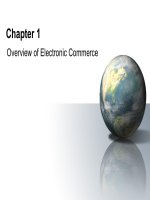Electric commerce chapter 2 e marketpaces structures, mechanisms, economics, and impacts
Bạn đang xem bản rút gọn của tài liệu. Xem và tải ngay bản đầy đủ của tài liệu tại đây (1.42 MB, 50 trang )
Chapter 2
E-Marketplaces:
Structures, Mechanisms,
Economics, and Impacts
Learning Objectives
1.
2.
3.
4.
5.
6.
Define e-marketplaces and list their components.
List the major types of e-marketplaces and describe their
features.
Describe the various types of EC intermediaries and
their roles.
Describe electronic catalogs, shopping carts, and search
engines.
Describe the various types of auctions and list their
characteristics.
Discuss the benefits, limitations, and impacts of
auctions.
Electronic Commerce
Prentice Hall © 2006
2
Learning Objectives
7.
8.
Describe bartering and negotiating online.
Define m-commerce and explain its role as a market
mechanism.
9. Discuss liquidity, quality, and success factors in emarketplaces.
10. Describe the economic impact of EC.
11. Discuss competition in the digital economy.
12. Describe the impact of e-marketplaces on organizations.
Electronic Commerce
Prentice Hall © 2006
3
E-Marketplaces
•
Markets (electronic or otherwise) have three main
functions:
1. Matching buyers and sellers;
2. Facilitating the exchange of information, goods, services,
and payments associated with market transactions; and
3. Providing an institutional infrastructure, such as a legal
and regulatory framework, which enables the efficient
functioning of the market.
Electronic Commerce
Prentice Hall © 2006
4
E-Marketplaces
•
Electronic marketplaces (e-marketplaces or
marketspaces), changed several of the processes
used in trading and supply chains
–
–
–
–
–
–
Greater information richness
Lower information search costs for buyers
Diminished information asymmetry between sellers and
buyers
Greater temporal separation between time of purchase and
time of possession
Greater temporal proximity between time of purchase and
time of possession
Ability of buyers and sellers to be in different locations
Electronic Commerce
Prentice Hall © 2006
5
E-Marketplaces
marketspace
A marketplace in which sellers and buyers exchange
goods and services for money (or for other goods
and services), but do so electronically
Electronic Commerce
Prentice Hall © 2006
6
E-Marketplaces
•
Marketspace components
– Customers
– Sellers
– Products and services
digital products
Goods that can be transformed into digital format
and delivered over the Internet
– Infrastructure
Electronic Commerce
Prentice Hall © 2006
7
E-Marketplaces
•
Marketspace components
front end
The portion of an e-seller’s business processes
through which customers interact, including the
seller’s portal, electronic catalogs, a shopping cart, a
search engine, and a payment gateway
back end
The activities that support online order-taking. It
includes fulfillment, inventory management,
purchasing from suppliers, payment processing,
packaging, and delivery
Electronic Commerce
Prentice Hall © 2006
8
E-Marketplaces
•
Marketspace components
intermediary
A third party that operates between sellers and
buyers.
– Other business partners
– Support services
Electronic Commerce
Prentice Hall © 2006
9
Types of E-Marketplaces:
From Storefronts to Portals
• Electronic Storefronts
storefront
A single company’s Web site where products or services
are sold
• Most common mechanisms are a(n):
– electronic catalog
– search engine
– electronic cart
– e-auction facilities
– payment gateway
Electronic Commerce
Prentice Hall © 2006
10
Types of E-Marketplaces:
From Storefronts to Portals
e-mall (online mall)
An online shopping center where many online stores
are located
• Types of Stores and Malls
– General stores/malls
– Specialized stores/malls
– Regional versus global stores
– Pure online organizations versus click-and-mortar stores
Electronic Commerce
Prentice Hall © 2006
11
Types of E-Marketplaces:
From Storefronts to Portals
• Types of E-Marketplaces
e-marketplace
An online market, usually B2B, in which buyers and
sellers exchange goods or services; the three types of emarketplaces are private, public, and consortia
private e-marketplaces
Online markets owned by a single company; may be
either sell-side or buy-side e-marketplaces.
Electronic Commerce
Prentice Hall © 2006
12
Types of E-Marketplaces:
From Storefronts to Portals
• Types of E-Marketplaces
sell-side e-marketplace
A private e-marketplace in which a company sells either
standard or customized products to qualified companies
buy-side e-marketplace
A private e-marketplace in which a company makes
purchases from invited suppliers
Electronic Commerce
Prentice Hall © 2006
13
Types of E-Marketplaces:
From Storefronts to Portals
public e-marketplaces
B2B marketplaces, usually owned and/or managed by
an independent third party, that include many sellers
and many buyers; also known as exchanges
information portal
A single point of access through a Web browser to
business information inside and/or outside an
organization
Electronic Commerce
Prentice Hall © 2006
14
Types of E-Marketplaces:
From Storefronts to Portals
• Six major types of portals
– Commercial (public) portals
– Corporate portals
– Publishing portals
– Personal portals
– Mobile portals
– Voice portals
Electronic Commerce
Prentice Hall © 2006
15
Types of E-Marketplaces:
From Storefronts to Portals
mobile portal
A portal accessible via a mobile device
voice portal
A portal accessed by telephone or cell phone
Electronic Commerce
Prentice Hall © 2006
16
Intermediation in EC
infomediaries
Electronic intermediaries that control information flow in cyberspace,
often aggregating information and selling it to others
• Five limitations of direct interaction
–
–
–
–
–
Search costs
Lack of privacy
Incomplete information
Contract risk
Pricing inefficiencies
Electronic Commerce
Prentice Hall © 2006
17
Exhibit 2.3 Infomediaries and the
Information Flow Model
Electronic Commerce
Prentice Hall © 2006
18
Intermediation in EC
e-distributor
An e-commerce intermediary that connects manufacturers
(suppliers) with business buyers by aggregating the
catalogs of many suppliers in one place—the
intermediary’s Web site
Electronic Commerce
Prentice Hall © 2006
19
Intermediation in EC
disintermediation
Elimination of intermediaries between sellers and
buyers
reintermediation
Establishment of new intermediary roles for traditional
intermediaries that have been disintermediated
Electronic Commerce
Prentice Hall © 2006
20
Electronic Catalogs and
Other Market Mechanisms
•
electronic catalogs
The presentation of product information in an electronic
form; the backbone of most e-selling sites
Classification of electronic catalogs
1. The dynamics of the information presentation
2. The degree of customization
3. Integration with business processes
Electronic Commerce
Prentice Hall © 2006
21
Electronic Catalogs and
Other Market Mechanisms
•
Online catalogs
– Ease of updating
– Ability to be integrated with the purchasing process
– Coverage of a wide spectrum of products
– Interactivity
– Customization
– Strong search capabilities
Electronic Commerce
Prentice Hall © 2006
22
Electronic Catalogs and
Other Market Mechanisms
•
Two approaches to creating customized catalogs
– Let the customers identify the parts of interest to them
from the total catalog
– Let the system automatically identify customer
characteristics based on the customer’s transaction
records
Electronic Commerce
Prentice Hall © 2006
23
Electronic Catalogs and
Other Market Mechanisms
search engine
A computer program that can access a database of
Internet resources, search for specific information or
keywords, and report the results
software (intelligent) agent
Software that can perform routine tasks that require
intelligence
Electronic Commerce
Prentice Hall © 2006
24
Electronic Catalogs and
Auctions as EC Market Mechanisms
electronic shopping cart
An order-processing technology that allows customers to
accumulate items they wish to buy while they continue to
shop
auction
A competitive process in which a seller solicits
consecutive bids from buyers (forward auctions) or a
buyer solicits bids from sellers (backward auctions).
Prices are determined dynamically by the bids
Electronic Commerce
Prentice Hall © 2006
25









